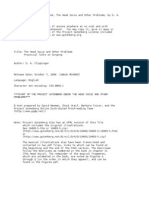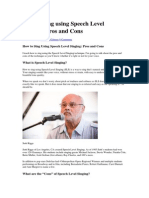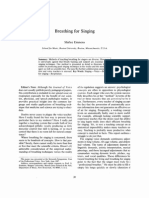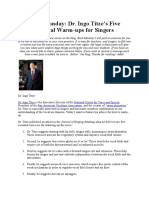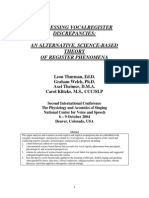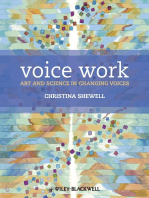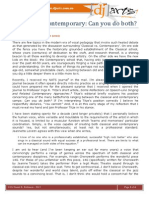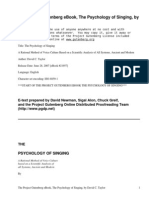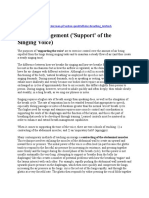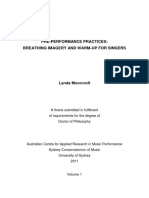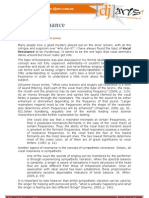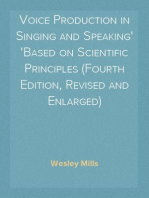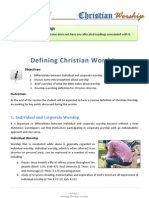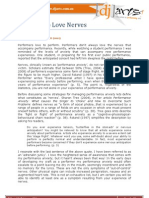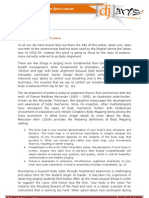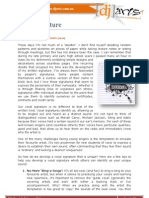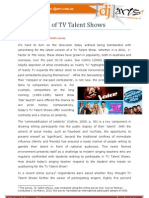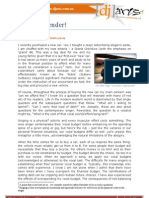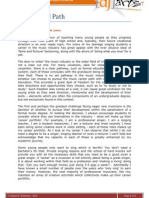Professional Documents
Culture Documents
Look Before You Leap
Uploaded by
Dr Daniel K. RobinsonOriginal Description:
Copyright
Available Formats
Share this document
Did you find this document useful?
Is this content inappropriate?
Report this DocumentCopyright:
Available Formats
Look Before You Leap
Uploaded by
Dr Daniel K. RobinsonCopyright:
Available Formats
Djarts Voice Coaching ~ www.djarts.com.
au
Look before you leap!
By Dr Daniel K. Robinson Recently, I read online via a news agency1 that another base jumper had been killed leaping from a telecommunications tower just north of Perth in Western Australia. Twenty-seven year old Lucas Oliver was an experienced skydiver and had recently turned to base jumping for the ultimate thrill . Despite the obvious dangers, I can appreciate the appeal of such activities. I have had the opportunity to sky-dive (twice); hang-glide off Australias most easterly point (Byron Bay) and occasionally, when Im feeling really game, I engage my mother-in-law in a conversation.2 Associated with each of these activities is a fantastic surge of adrenalin. Why? Because there are a number of things that can go wrongand if they do, it can be catastrophic! Of course, the flip side to the highly calculated risk is the ecstasy of living on the edge and doing something that invigorates the lives of the people who participate in extreme sport activities. Its worth noting as we proceed, that within the classification of extreme sports, there is a range from the relatively mundane (BMX and Jet Skiing) to the most life-threatening activity of base jumping. Practically speaking, there is no risk to ones life while singing popular culture music (PCM3)4, but there are associated risks to vocal health. Any compromise to vocal health can have a variety of outcomes, from the need for short-term vocal rest to corrective surgery requiring a long-term remedial journey.
5
Any
interruption of a vocalists ability to enjoy the activity of singing is problematic and distressing; not to mention the impact of lost income for the professional singer due to enforced vocal rest. This all sounds very negative but take heart; just as a base jumper engages with his extreme sport in a calculated fashion, so can contemporary vocalists enjoy the exhilaration of extreme vocal use with a deliberate, premeditated, and skillful approach.
Dr Daniel K. Robinson - 2012
1 Page 1 of 13
Djarts Voice Coaching ~ www.djarts.com.au
As mentioned earlier, there is a range of risk levels within the classification of extreme sports; and so it is with contemporary vocals. The world of contemporary voice ranges from jazz and gospel at one end; to death, thrash and slash metal at the other. On this spectrum of genres is a range of vocal use/loads which carry their own required application of the voice. It is important to note at this point that I concur with esteemed ENT, Dr. Robert Sataloff, when he writes, With sufficient understanding, patience, voice team skill, and patient compliance, a vocally right way can be found to do almost anything.6 Furthermore, it is important to stress that a musical genre is not the bad-guy; as Irene Bartlett suggests when she writes, Style in itself does not cause damage to the vocal instrument; poor technique does.7 So it is with these delimiters in place (style is not bad; poor technique is bad) that we proceed with identifying some of the inherent technical challenges facing the contemporary vocalist.8
The Naughty but Nice List Simply put, almost any practice taken to its extreme can be foolhardy as well as dangerous. The key is to work towards developing healthy sustainable habits which allow, in the case of the contemporary singer, the choice to indulge in the naughty but nice list9 of vocal effects. Lets run through a range (not exhaustive) of vocal effects that many contemporary genres require of their vocal artists: Aspirated Voice: Breathiness is a great vocal effect which can create a
stylistic quality needed in genres such as jazz and pop ballads. However, the voice that is habitually aspirated (breathy) runs the risk of developing vocal pathologies such as nodules, not to mention the challenge of reduced breath stream prolongation. Without discounting the stylistic benefits of an aspirated voice, some singers, including those with heavy vocal load schedules and those with a history of voice damage (particularly nodules), will benefit from the alternate tonal quality which I describe as ambient tone. The ambient tone is achieved through the balanced activity of the shortener (thyroarytenoid) and lengthener (cricothyroid
Dr Daniel K. Robinson - 2012
and
cricoarytenoid) musculature.10 This
balanced
2 Page 2 of 13
Djarts Voice Coaching ~ www.djarts.com.au
muscle activity, when combined with measured breath flow and appropriate vocal tract shaping (kinesthetically adjusted by the singer), results in a softly resonant sound not dissimilar to that of the aspirated voice; but minus the dense flow of air and injurious interruption to the vocal fold ripple wave which may be observed in an aspirate voice. The highly adjustable sound of ambient tone seems to mechanistically sit within Johan Sundbergs description of flow phonation11 in which categorical descriptors for the range of perceived voice qualities during flow phonation are firm-flutier to richer-warm/mellow to richestbrassier.12 Specifically, the ambient tone engages the laryngeal apparatus in such a way as to achieve complete (or essentially complete) closed-phase contact during mucosal waving in relation to an optimal range of phonation threshold pressures.13 That is, mechanistically ambient tone is nearly aspirated but not quite! Vocal Fry: The raspy (and at times pressed) edge to a sound is often
referred to as vocal fry. Creatively described in the literature as a sound resembling that of frying food, 14 the term vocal fry as applied here should not be confused with its customary usage in referencing registers.15 Responding to the question, Wont vocal fry cause nodules? contemporary practitioner James Wigginton writes, Habitual fry, just like habitual throat clearing, or habitual donuts, can be damaging.16 Wiggintons playful response does not dismiss the risks associated with vocal fry which has been listed among five17 sound qualities which might characterize a voice as dysphonic, or as presenting a dysphonia.18 Wigginton goes on to commend the use of vocal fry for the display of style and song interpretation.19 Vocal Onsets: There are a range of vocal fold onsets (the way the vocal
folds commence phonation). Breathy onset, also known as soft attack, whispery or aspirate onset,20 commences vocal fold vibration with an audible breath escap[ing] before phonation begins.21 Hard onset, also known as pressed or glottal onset, hard or glottal attack, initiates tone with the vocal folds closing tightly before phonation starts.22 Vocal onsets (there is also balanced onset) are used to shape the phrase with varying artistic expressions. Attention to vocal
3 Page 3 of 13
Dr Daniel K. Robinson - 2012
Djarts Voice Coaching ~ www.djarts.com.au
onsets is important because, as I say to my students, The way the voice starts a phrase is the way it is likely to finish the phrase. Specifically, if the voice onsets with a glottal attack, the ensuing phrase will have a predetermination towards pressed phonation. Again, the associated risks of vocal onsets can be attributed to the level of habitual use by the singer. I direct my students towards a habitually balanced onset while instructing the ability to access aspirate onset and glottal attacks as the repertoire requires. Additionally, I have noted anecdotally that the balanced onset (when used habitually) has a lower predilection to vocal fatigue than that of aspirate and hard onsets. The term vocal fatigue refers specifically to deterioration in the quality of phonation over time, with a loss of vocal stamina and the risk of an extra increase in effort.23 The challenge presented by vocal fatigue to the contemporary singer will be addressed further when we review muscular conditioning later in the article. Pressed Phonation: In genres such as rock and punk it is stylistically
appropriate to apply a pressed phonation to some material. Pressed phonation is often characterized as an extreme vocal activity requiring skillful application. Gillyanne Kayes writes, If you make a rasping sound or feel something scratch in the larynx, you have either constricted the false folds or have pushed with the true vocal folds.24 Kayes defines this constricted, pushed vocal activity as Pressed Phonation.25 Pressed phonation is often used by the vocalist to express intensity and high energy. An associated risk for the voice that regularly employs pressed phonation is heightened vocal fatigue along with possible pathological injuries such as vocal polyps which most commonly result from extensive and strenuous voice use with high impact and shearing forces over time.26 Vocal Distortion: The application of purposefully distorted voice is often
observed in the Metal genres of contemporary music. Daniel Zangger Borch, when defining vocal distortion writes, Some singers, particularly women, have trouble producing a distorted tone and others get a sore throat when trying.27 Borch goes on to suggest that creating vocal distortion requires a lot of lung pressure and energy.28 An ever-present danger for the distorted voice is vocal fold bruising, or hemorrhage: Vocal fold hemorrhage may occur following highly
4 Page 4 of 13
Dr Daniel K. Robinson - 2012
Djarts Voice Coaching ~ www.djarts.com.au
forceful or loud voicingCommon contributors to hemorrhages are sudden very loud screaming or the frequent use of strong glottal attacks.29 Vocal distortion is the base jumping of contemporary voice and should be approached with careful mechanistic set-up and always under the watchful eye of an experientially knowledgeable instructor.30 Before continuing it is important to note the heightened muscle conditioning required for these extreme uses of the voice. While identifying three modes of whole muscle contraction (Isometric, Eccentric, and Concentric)31 and the required muscle conditioning for efficient singing Thurman et al. write,
Repeated high variability of voice use over increasingly longer time spans, results in nuanced skill building and in optimal conditioning of all the laryngeal motor units and muscle fibersOptimal contractile strength (force), contractile speed, precision, and smoothness (responsivity, quickness, accuracy, agility), and neuromuscular endurance all can be developed when body/minds enact an appropriately wide range of pitches, volumes, qualities, and durations with increasingly optimum and acoustic efficiency.32
As with any extreme exercise and muscle use the necessity for vocal rest following singing activities utilizing contemporary vocal effects cannot be overstated. Again, Thurman et al. are helpful here:
When muscle-use demands exceed the current level of conditioning, then fatigue of the neuromuscular metabolic resources occurs. If demand passes the current level of conditioning to a relatively small degree, an adaptive or conditioning effect occurs during a comparatively short rest or recovery time.33
Disallowing or ignoring the need for vocal rest can result in vocal wear and tear which might be experienced acutely in the short term and observed in gradual decline of vocal efficiencies over the long term.34
Dr Daniel K. Robinson - 2012
5 Page 5 of 13
Djarts Voice Coaching ~ www.djarts.com.au
Breath and Laryngeal Co-ordination Allow me now to highlight two mechanistic themes that occur in each of the naughty but nice list: breath stream and laryngeal mechanism. It has been my pedagogical conviction for some time that one of the major differences between rigorous classical instruction and equally rigorous contemporary instruction is the manner in which air is supplied through the larynx. Many contemporary genre vocals require a thyroarytenoid (TA) dominant mechanism. Because the TA muscle is often already dominantly engaged for the contemporary singer, any significant increase in the sub-glottal pressure may cause the TA to activate further causing hyper-tension which might be experienced as constriction. In his handbook, Ultimate Vocal Voyage, Zangger Borch writes, If the air delivered to the larynx is under too much pressure the vocal folds will have to fight to hold back some of it while simultaneously producing a tone.35 Explicitly, in order to maintain a healthy, balanced tone, the contemporary vocalist needs to manage the breath stream by intentionally, at times, reducing the sense of pressure directly below the vocal folds. Of course, as previously noted, the alternate is also true; to achieve many contemporary vocal effects registered on the naughty but nice list, the skillful singer needs to purposefully heighten the sense of sub-glottal pressure in order to acquire a specific aesthetic outcome. The complexity of this air-pressure to muscle-activity ratio necessitates skillful application most often developed under the guidance of the aforementioned knowledgeable teacher, and requires trustworthy kinesthetic awareness on the part of the singer, and extensive work on a breath management system that can be malleable. I have observed that while many students can, with patient practice, develop a heightened sense of physical awareness (laryngeal pressure, resonance sensations, etc.); some students struggle to connect with their instruments and the subtle sensations that their bodies/instruments give out. The students own hands placed on different parts of his body are valuable in drawing attention to muscular activity and vibration caused by his own sound making. The use of a full length mirror is also valuable; and while self-conscious students may
Dr Daniel K. Robinson - 2012 6 Page 6 of 13
Djarts Voice Coaching ~ www.djarts.com.au
hesitate (even refuse) to view themselves in the mirror, gentle, persuasive encouragement should be applied to facilitate the development of physical familiarity with their entire instrument while singing with both efficient and inefficient voice technique. The use of a studio mirror is also helpful for self-directed attention to body alignment. Contemporary singers, like many of their classical peers, have a tendency to succumb to excessive engagement of the extrinsic musculature of the neck; thrusting the head forward. When asked about neck protrusion during singing, Richard Miller responded Muscle antagonism in any part of the body brings clearer muscle definition, but enlargement of the leaders of the neck at phrase endings, or in high-lying passages, may be indicative of excessive subglottic pressure or of excessive muscle antagonism.36 The visual feedback gained from the studio mirror enables self-awareness and empowers the development of refined body-mind connections. Additionally, I encourage a buoyant body in all my contemporary singing students. Developing a buoyant body state through heightened awareness is challenging and takes time for the student-singer to master. It has been my experience in observing singing students that bodies often do the most unusual things in order to physically support the voice. One way that the singer can monitor and maintain a balanced alignment (buoyant body), while managing their tension during practice and performance is to ensure that their weight is constantly over the balls of their feet. Zangger Borch agrees: Putting too much weight on your heels can increase the strain on your larynx...A suitable relaxed and balanced position may feel like you are leaning slightly forward with your weight on the front of your ankles.37 Sataloff also endorses the forward buoyant position by encouraging singers to have their feet apart, not more apparent than the width of the shoulders. Many singers prefer to have one foot slightly forward.38 Finally, without seeking to add fuel to the fire that rages around the debate concerning the best breath management systems, I have found that the Accent Breath Method is particularly helpful in empowering students with a sense of physical control over their breath stream and the variable pressures that it can
7 Page 7 of 13
Dr Daniel K. Robinson - 2012
Djarts Voice Coaching ~ www.djarts.com.au
place upon the larynx. Classical voice pedagogues, Janice Chapman and Ron Morris, explain that Accent Breath employs a conscious release of the abdominal muscles which in turn does not recruit any expiratory muscles during the inbreath, but relies on a flexible abdominal wall which allows the diaphragm to descend quickly, fully, and efficiently.39 The payoff for contemporary singers when they employ the SPLAT (Singers Please Loosen Abdominal Tension) of Accent Breath Method is the way in which the TA muscles need to dynamically release and purposefully retract on inhalation; tension management informed by breath management. Plainly, a well-balanced voice will be able to make choices more readily than a voice that is habitually constricted, and that even means making the choice to sound aspirated, pressed, or even distorted. In closing, I am eager to stress that a right-way can be formed for most, if not all, vocal styles. Its also worth noting that just because our current understandings of voice may limit our abilities to form healthy technique for a particular genre (not to mention the genres that have yet to emerge) that does not mean that future knowledge and discovery wont empower the development of new and better techniques. Many contemporary voice styles are the extreme sports of the singing world. Some genres are inherently loaded with more risk than others, but this does not mean that they should be avoided, or more importantly, will be avoided. Why are people drawn to participate in certain sports? Lucas Oliver, the base jumper mentioned in the beginning of this article, died doing what he loved; he understood the risks, but chose to participate in the sport anyway. The responsibility of all singers (and their singing teachers) engaged in the artistic expression of extreme contemporary vocalizes is to understand the risks and work towards mitigating the risks through the employment of efficient, taskspecific technique. Personally, I wont tell base jumpers not to jump if Im standing next to them at the edge of a cliff, but Ill always recommend, Look before you leap!
Dr Daniel K. Robinson - 2012
8 Page 8 of 13
Djarts Voice Coaching ~ www.djarts.com.au
NOTES
AAP,
"Base
Jumper
Died
'Doing
What
He
Loved',"(2011),
http://news.ninemsn.com.au/national/8204252/base-jumper-died-doing-what-he-loved. (accessed 25 November, 2011) 2 3 Dont send me lettersIm only joking! Diane Hughes defines popular culture music as, encompassing both
mainstream and alternative styles,[it] is a term that is inclusive of all music styles in popular culture. While Contemporary Commercial Music (CCM) is the accepted term among many pedagogues I prefer PCM due to its true inclusivity of all popular music. Additionally, I write a lot in the area of Contemporary Christian Music (CCM) so the use of PCM has obvious benefits of distinction. 4 Diane Hughes, "Developing Vocal Artistry in Popular Culture Musics," in Perspectives on Teaching Singing: Australian Vocal Pedagogues Sing Their Stories, ed. Scott D. Harrison (Brisbane, QLD: Australian Academic Press, 2010), 245. 5 Without wanting to be alarmist, the rarest of voice damage cases can result in the singer losing significant levels of vocal facility; rendering the vocalist handicapped. Christiana Shewell, Voice Work: Art and Science in Changing Voices (West Sussex, United Kingdom: Wiley-Blackwell, 2009), 415. 6 Robert T. Sataloff, ed. Vocal Health and Pedagogy: Advanced Assessment and Treatment, 2nd ed., vol. 2 (San Diego, CA: Plural Publishing Inc.,2006), 285. 7 Irene Bartlett, "One Size Doesn't Fit All: Tailored Training for Contemporary Commercial Singers," in Perspectives on Teaching Singing: Australian Vocal Pedagogues Sing Their Stories, ed. Scott D. Harrison (Brisbane, QLD: Australian Academic Press, 2010), 234. 8 There are a range of cultural challenges facing todays contemporary singer also. The scope of this article does not provide for the discussion of lifting heavy gear before/after gigs, talking in loud bars, eating late etc.; but these issues should be considered (as well as many others) as important concerns for the contemporary singer.
Dr Daniel K. Robinson - 2012
9 Page 9 of 13
Djarts Voice Coaching ~ www.djarts.com.au
9 Despite being unable to acknowledge the source (unknown) of the term I am keen to note that Naughty but Nice is not my own created work, but is a borrowed label of vernacular use among many Australian contemporary singing teachers. 10 I am intentionally avoiding the use of the term mix here because of its inherent redundancy. Most, if not all, vocal sounds are a mix of mechanism and resonance qualities; so to use the term mix to identify a point in the voice (register transitions) or specific sound quality can be, to my mind, misleading and possibly confusing to the student singer. 11 Johan Sundberg, The Science of the Singing Voice (Dekald, IL: Northern Illinois University Press, 1987), 80. 12 Leon Thurman et al., "How Your Larynx Contributes to Basic Voice Qualities," in Bodymind and Voice: Foundations of Voice Education, ed. Leon Thurman and Graham Welch (St. John's University, MI: The VoiceCare Network, 2000), 418. 13 Ibid., 418. 14 Robert Bastian, Leon Thurman, and Carol Klitzke, "Limitations to Vocal Ability from Use-Related Injury or Atrophy," in Bodymind and Voice: Foundations of Voice Education, ed. Leon Thurman and Graham Welch (St. John's University, MI: The VoiceCare Network, 2000), 530. 15 Please note that as a student of the Thurman and Welch registration model (Pulse, Lower, Upper and Flute/ Falsetto) I label the lowest register of the voice as Pulse Register. This in turn accounts for any confusion that might be caused by the duplicitous use of the term vocal fry. For a complete treatment of this model I draw the readers attention to Thurman et al., "The Voice Qualities That Are Referred to as 'Vocal Registers'," 42148. 16 James R. Wigginton, "When 'Proper' Is Dead Wrong: How Traditional Methods Fail Aspiring Artists," Journal of Singing 66, no. 4 (2010): 448. 17 The five sound qualities are: breathiness, roughness, hoarseness, tenseness and vocal fry: Bastian, Thurman, and Klitzke, "Limitations to Vocal Ability from UseRelated Injury or Atrophy," 530. 18 Ibid., 530.
Dr Daniel K. Robinson - 2012
10 Page 10 of 13
Djarts Voice Coaching ~ www.djarts.com.au
19 Wigginton, "When 'Proper' Is Dead Wrong: How Traditional Methods Fail Aspiring Artists," 448. 20 Shewell, Voice Work: Art and Science in Changing Voices, 172. 21 Ibid., 172. 22 Ibid., 172. 23 Ibid., 116. 24 Gillyanne Kayes, Singing and the Actor, 2nd ed. (New York, NY: Routledge, 2004), 115. 25 Ibid., 115.
26
Bastian, Thurman, and Klitzke, "Limitations to Vocal Ability from Use-Related
Injury or Atrophy," 531.
27
Daniel Zangger Borch, Ultimate Vocal Voyage: The Definitive Method for
Unleashing the Rock, Pop or Soul Singer within You (Bromma, Sweden: Notfabriken Music Publishing AB, 2005), 62.
28
Ibid., 62. Bastian, Thurman, and Klitzke, "Limitations to Vocal Ability from Use-Related
29
Injury or Atrophy," 533.
30
For more specific work outlining the vocal techniques required for vocal
distortion the interested reader is recommended to visit the work of Cathrine Sadolin (Complete Vocal Institute) and Melissa Cross (Zen of Screaming) as two of the worlds leading methodologist in this field.
31
Thurman et al., "Vocal Efficiency and Vocal Conditioning in Expressive Speaking
and Singing," 499.
32
Ibid., 499500. Ibid., 505. The scope of this article does not provide space to discuss the importance of
33
34
vocal warm-ups and cool downs. The inability to highlight these disciplines here should not detract from their importance and regular employment.
Dr Daniel K. Robinson - 2012
11 Page 11 of 13
Djarts Voice Coaching ~ www.djarts.com.au
35
Borch, Ultimate Vocal Voyage: The Definitive Method for Unleashing the Rock,
Pop or Soul Singer within You, 35.
36
Richard Miller, Solutions for Singers: Tools for Performers and Teachers (New
York, NY: Oxford University Press, 2004), 46.
37
Borch, Ultimate Vocal Voyage: The Definitive Method for Unleashing the Rock,
Pop or Soul Singer within You, 17.
38
Sataloff,
ed.
Vocal
Health
and
Pedagogy:
Advanced
Assessment
and
Treatment, 275.
39
Janice L. Chapman and Ron Morris, "Breathing and Support," in Singing and
Teaching Singing: A Holistic Approach to Classical Voice, ed. Janice L. Chapman (San Diego, CA: Plural Publishing Inc., 2006), 41.
Dr Daniel K. Robinson - 2012
12 Page 12 of 13
Djarts Voice Coaching ~ www.djarts.com.au
Dr Daniel K. Robinson Daniel is a freelance artist and educator. In 2011 Daniel completed his Doctor of Musical Arts degree at the Queensland Conservatorium Griffith University. He has served as National Vice President (200911) and National Secretary for the Australian National Association of Teachers of Singing (2006 11). In 2010 Daniel authored the chapter Teaching the Contemporary Worship Singer for the acclaimed text, Perspectives on Teaching Singing (ed. Harrison) Daniel recently co-authored the chapter Singing in Church: The Role of Men in Contemporary Worship Singing with friend and colleague Dr Scott Harrison (Queensland Conservatorium, Griffith University) for the text Perspectives on Men and Singing (ed. Harrison, Welch and Adler, 2012). Daniel is the principal Singing Voice Specialist for Djarts
(www.djarts.com.au) and presents workshops and seminars to Contemporary Worship Singers across Australia and abroad. Daniel also regularly writes on the culture of Christian worship through his widely read blog:
www.voiceinworship.com. He and his wife Jodie have three children and live in Brisbane, Queensland Australia.
Dr Daniel K. Robinson - 2012
13 Page 13 of 13
You might also like
- Berklee Vocal Health For SingersDocument15 pagesBerklee Vocal Health For Singersrosalie_elena89% (9)
- Vocal PedagogyDocument108 pagesVocal PedagogymaulanaNo ratings yet
- Vocal PedagogyDocument67 pagesVocal Pedagogyzeuta1100% (3)
- Vocal Pedagogy 2007Document51 pagesVocal Pedagogy 2007Dennis Räll100% (4)
- The Head Voice and Other ProblemsPractical Talks On Singing by Clippinger, D. A. (David Alva), 1860-1938Document67 pagesThe Head Voice and Other ProblemsPractical Talks On Singing by Clippinger, D. A. (David Alva), 1860-1938Gutenberg.org100% (5)
- Unhealthy vocal techniques among amateur and professional singersDocument84 pagesUnhealthy vocal techniques among amateur and professional singersMusteata Alexandr100% (1)
- Vocal Singing 101 Bekley ProgramDocument52 pagesVocal Singing 101 Bekley ProgramVeron Pabon100% (1)
- Vocal Pedagogy ResourcesDocument2 pagesVocal Pedagogy Resourcesjsha249286% (14)
- LessonPlans VocalDocument53 pagesLessonPlans VocalLorena Do Val100% (2)
- Classical Vs ContemporaryDocument2 pagesClassical Vs ContemporaryDr Daniel K. RobinsonNo ratings yet
- How To Sing Using Speech Level SingingDocument5 pagesHow To Sing Using Speech Level SingingFrancois OlivierNo ratings yet
- Leading Christian WorshipDocument14 pagesLeading Christian WorshipDr Daniel K. Robinson100% (1)
- Breathing For SingingDocument6 pagesBreathing For SingingsopranopatriciaNo ratings yet
- Vocal Health and Voice CareDocument15 pagesVocal Health and Voice CareDr Daniel K. Robinson100% (6)
- Vocal Post Mix: by DR Daniel K. RobinsonDocument4 pagesVocal Post Mix: by DR Daniel K. RobinsonDr Daniel K. RobinsonNo ratings yet
- Vocal Post Mix: by DR Daniel K. RobinsonDocument4 pagesVocal Post Mix: by DR Daniel K. RobinsonDr Daniel K. RobinsonNo ratings yet
- A Practical Guide For First-Year Graduate Teaching Assistants in VoiceDocument73 pagesA Practical Guide For First-Year Graduate Teaching Assistants in VoiceEl Ghali100% (1)
- Dr. Ingo Titze's Five Favorite Vocal Warm-Ups For SingersDocument2 pagesDr. Ingo Titze's Five Favorite Vocal Warm-Ups For SingersGautam Malhotra100% (3)
- Functional Voice Training Through Jazz Literature and StyleDocument32 pagesFunctional Voice Training Through Jazz Literature and StylewobblegobbleNo ratings yet
- Vocal Issues PDFDocument50 pagesVocal Issues PDFAlicia TaylorNo ratings yet
- Complete Vocal Fitness PreviewDocument6 pagesComplete Vocal Fitness Previewvikas kunduNo ratings yet
- Lindquest Exercices PDFDocument228 pagesLindquest Exercices PDFCinqMarsNo ratings yet
- Belting and A High Laryngeal Position-TitzeDocument3 pagesBelting and A High Laryngeal Position-TitzeBrenda Iglesias50% (2)
- 9 Things Singers Need To Know About Their Bodies - Total Vocal FreedomDocument21 pages9 Things Singers Need To Know About Their Bodies - Total Vocal FreedomElina Georgieva100% (2)
- Voice Anatomy 101Document15 pagesVoice Anatomy 101Dr Daniel K. Robinson100% (13)
- Music in Christian WorshipDocument15 pagesMusic in Christian WorshipDr Daniel K. Robinson100% (2)
- Everyday Voice Care: The Lifestyle Guide for Singers and TalkersFrom EverandEveryday Voice Care: The Lifestyle Guide for Singers and TalkersRating: 4.5 out of 5 stars4.5/5 (4)
- Vocal PedagogyDocument20 pagesVocal PedagogyDhei TulinaoNo ratings yet
- Breathe In, Breathe OutDocument3 pagesBreathe In, Breathe OutDr Daniel K. Robinson75% (4)
- Vocal Health For Young Singers: by Guest Writer Sarah BlakesleeDocument3 pagesVocal Health For Young Singers: by Guest Writer Sarah BlakesleeclaugmailNo ratings yet
- Vocal Straw Exercises: Instructor: Ingo TitzeDocument1 pageVocal Straw Exercises: Instructor: Ingo TitzeKyrie CourterNo ratings yet
- In Practice: TransitionsDocument4 pagesIn Practice: TransitionsDr Daniel K. Robinson100% (2)
- A Science-Based Explanation of Vocal RegistersDocument64 pagesA Science-Based Explanation of Vocal RegistersMark Del Monte Reginio100% (1)
- EcR - 1 Leading and Lagging IndicatorsDocument10 pagesEcR - 1 Leading and Lagging IndicatorsMiloš ĐukićNo ratings yet
- Working with Adolescent VoicesDocument15 pagesWorking with Adolescent VoicesDanHasALamb100% (2)
- QRF HD785-7Document2 pagesQRF HD785-7Ralf MaurerNo ratings yet
- ABCD Vocal Technique Handout PDFDocument9 pagesABCD Vocal Technique Handout PDFRanieque RamosNo ratings yet
- Building Vocal Strength With Sustained Tone Warm-UpsDocument8 pagesBuilding Vocal Strength With Sustained Tone Warm-UpsAna Catarina CaseiroNo ratings yet
- Developmental History of Christian Worship 1Document16 pagesDevelopmental History of Christian Worship 1Dr Daniel K. Robinson100% (4)
- Coaching The Singing Voice PDFDocument3 pagesCoaching The Singing Voice PDFAngel Andres BlancoNo ratings yet
- Classical and Contemporary: Can You Do Both?Document4 pagesClassical and Contemporary: Can You Do Both?Dr Daniel K. RobinsonNo ratings yet
- The Psychology of SingingA Rational Method of Voice Culture Based On A Scientific Analysis of All Systems, Ancient and Modern by Taylor, David C.Document114 pagesThe Psychology of SingingA Rational Method of Voice Culture Based On A Scientific Analysis of All Systems, Ancient and Modern by Taylor, David C.Gutenberg.org100% (3)
- Work, Rest and PlayDocument6 pagesWork, Rest and PlayDr Daniel K. Robinson100% (1)
- Energy vs. EffortDocument2 pagesEnergy vs. EffortDr Daniel K. Robinson100% (3)
- Developmental History of Christian Worship 2Document21 pagesDevelopmental History of Christian Worship 2Dr Daniel K. RobinsonNo ratings yet
- How To Use A Vocal CoachDocument7 pagesHow To Use A Vocal Coachclaugmail100% (1)
- Wastewater Treatment Plant Design PDFDocument68 pagesWastewater Treatment Plant Design PDFmostafa1alaahobaNo ratings yet
- Breath SupportDocument19 pagesBreath SupportsopranopatriciaNo ratings yet
- The Child-Voice in SingingDocument61 pagesThe Child-Voice in SingingLuminitzaNo ratings yet
- 4.3 Laryngeal Muscle ActivityDocument12 pages4.3 Laryngeal Muscle ActivityKarolyna Giraldo S.No ratings yet
- Miller Richard - Vocal PedagogyDocument18 pagesMiller Richard - Vocal PedagogyEdvan EvangelistaNo ratings yet
- Today's Worship ConstructsDocument18 pagesToday's Worship ConstructsDr Daniel K. Robinson100% (1)
- Headvoiceinchoir PDFDocument9 pagesHeadvoiceinchoir PDFtempestchanNo ratings yet
- Natural Singing - A Guide For Using The Alexander Technique To Tea PDFDocument44 pagesNatural Singing - A Guide For Using The Alexander Technique To Tea PDFChris ArnoneNo ratings yet
- Vocology PaperDocument119 pagesVocology PaperJakarra100% (2)
- Vowels and PitchDocument64 pagesVowels and PitchIgor Correia100% (1)
- Breath Management ('Support' of The Singing Voice)Document6 pagesBreath Management ('Support' of The Singing Voice)Jeyashankar Ramakrishnan100% (1)
- Breathing Imagery and Vocal Warm-Up for SingersDocument383 pagesBreathing Imagery and Vocal Warm-Up for SingersJanaki100% (1)
- Singing Warm UpsDocument3 pagesSinging Warm UpsAbigail TuckerNo ratings yet
- Vocal ResonanceDocument2 pagesVocal ResonanceDr Daniel K. RobinsonNo ratings yet
- Vocal ResonanceDocument2 pagesVocal ResonanceDr Daniel K. RobinsonNo ratings yet
- Scaffolding Control & MeasuresDocument3 pagesScaffolding Control & Measuresviswamanoj100% (1)
- Guide to Using the SOVT StrawDocument20 pagesGuide to Using the SOVT StrawAnca O100% (1)
- Benefits at Cognizant Technology SolutionsDocument5 pagesBenefits at Cognizant Technology Solutions8130089011No ratings yet
- Jesse Nemitz Top 7 Secrets of The Super High MixDocument4 pagesJesse Nemitz Top 7 Secrets of The Super High MixMarcos Muñoz LamaNo ratings yet
- Pitch & IntonationDocument2 pagesPitch & IntonationDr Daniel K. Robinson100% (1)
- Alternate Mekton Zeta Weapon CreationDocument7 pagesAlternate Mekton Zeta Weapon CreationJavi BuenoNo ratings yet
- Voice Production in Singing and Speaking Based on Scientific Principles (Fourth Edition, Revised and Enlarged)From EverandVoice Production in Singing and Speaking Based on Scientific Principles (Fourth Edition, Revised and Enlarged)No ratings yet
- Cfm56-3 Engine Regulation by CFMDocument43 pagesCfm56-3 Engine Regulation by CFMnono92100% (5)
- Defining Christian WorshipDocument8 pagesDefining Christian WorshipDr Daniel K. RobinsonNo ratings yet
- Learning To Love NervesDocument2 pagesLearning To Love NervesDr Daniel K. RobinsonNo ratings yet
- Learning To Love NervesDocument2 pagesLearning To Love NervesDr Daniel K. RobinsonNo ratings yet
- Learning LyricsDocument1 pageLearning LyricsDr Daniel K. Robinson100% (1)
- NodulesDocument1 pageNodulesDr Daniel K. RobinsonNo ratings yet
- Body LineDocument2 pagesBody LineDr Daniel K. RobinsonNo ratings yet
- Process Over ProductDocument4 pagesProcess Over ProductDr Daniel K. RobinsonNo ratings yet
- Pedagogy and Vocal JazzDocument2 pagesPedagogy and Vocal JazzTeh Yoong WeiNo ratings yet
- The Learning PathwayDocument5 pagesThe Learning PathwayDr Daniel K. Robinson100% (3)
- Process Over ProductDocument4 pagesProcess Over ProductDr Daniel K. RobinsonNo ratings yet
- Vocal SignatureDocument3 pagesVocal SignatureDr Daniel K. Robinson100% (1)
- Baptism and The Lord's SupperDocument11 pagesBaptism and The Lord's SupperDr Daniel K. RobinsonNo ratings yet
- The Impact of TV Talent ShowsDocument6 pagesThe Impact of TV Talent ShowsDr Daniel K. RobinsonNo ratings yet
- Hey Big SpenderDocument3 pagesHey Big SpenderDr Daniel K. Robinson100% (1)
- Designing Worship With Positive TensionsDocument13 pagesDesigning Worship With Positive TensionsDr Daniel K. RobinsonNo ratings yet
- Body LineDocument2 pagesBody LineDr Daniel K. RobinsonNo ratings yet
- Passionate SingingDocument2 pagesPassionate SingingDr Daniel K. RobinsonNo ratings yet
- Apex SkillsDocument2 pagesApex SkillsDr Daniel K. RobinsonNo ratings yet
- Vocal Warm UpsDocument2 pagesVocal Warm UpsDr Daniel K. Robinson100% (1)
- The Critical PathDocument2 pagesThe Critical PathDr Daniel K. RobinsonNo ratings yet
- The Bare EssentialsDocument2 pagesThe Bare EssentialsDr Daniel K. RobinsonNo ratings yet
- MEDICO-LEGAL ASPECTS OF ASPHYXIADocument76 pagesMEDICO-LEGAL ASPECTS OF ASPHYXIAAl Giorgio SyNo ratings yet
- Thee Correlational Study of Possittive Emotionons and Coping Strategies For Academic Stress Among CASS Studentts - updaTEDDocument23 pagesThee Correlational Study of Possittive Emotionons and Coping Strategies For Academic Stress Among CASS Studentts - updaTEDJuliet AcelNo ratings yet
- C. Drug Action 1Document28 pagesC. Drug Action 1Jay Eamon Reyes MendrosNo ratings yet
- Philippines implements external quality assessment for clinical labsDocument2 pagesPhilippines implements external quality assessment for clinical labsKimberly PeranteNo ratings yet
- Pulsar2 User Manual - ENDocument83 pagesPulsar2 User Manual - ENJanette SouzaNo ratings yet
- Funds Flow Statement ExplainedDocument76 pagesFunds Flow Statement Explainedthella deva prasad0% (1)
- AAR Maintenance 001Document3 pagesAAR Maintenance 001prakash reddyNo ratings yet
- ERS M22 PC4 FerryDocument2 pagesERS M22 PC4 FerryouakgoodNo ratings yet
- Construction and Operation 1. Air Conditioning Control PanelDocument18 pagesConstruction and Operation 1. Air Conditioning Control PanelRoma KuzmychNo ratings yet
- 2016.05.16 - Org ChartDocument2 pages2016.05.16 - Org ChartMelissaNo ratings yet
- UT Dallas Syllabus For nsc4371.001.11s Taught by Michael Kilgard (Kilgard)Document5 pagesUT Dallas Syllabus For nsc4371.001.11s Taught by Michael Kilgard (Kilgard)UT Dallas Provost's Technology GroupNo ratings yet
- LH 11 180 190 220 230 270 280 390 400 Breaker Safety & Operating InstructionsDocument304 pagesLH 11 180 190 220 230 270 280 390 400 Breaker Safety & Operating InstructionshadensandorNo ratings yet
- Ethamem-G1: Turn-Key Distillery Plant Enhancement With High Efficiency and Low Opex Ethamem TechonologyDocument25 pagesEthamem-G1: Turn-Key Distillery Plant Enhancement With High Efficiency and Low Opex Ethamem TechonologyNikhilNo ratings yet
- Synthesis, Experimental and Theoretical Characterizations of A NewDocument7 pagesSynthesis, Experimental and Theoretical Characterizations of A NewWail MadridNo ratings yet
- 01 - 01 - SK10 - JXNipponDocument1 page01 - 01 - SK10 - JXNipponredevils86No ratings yet
- The Girls Center: 2023 Workout CalendarDocument17 pagesThe Girls Center: 2023 Workout Calendark4270621No ratings yet
- Daudo PH-396PVP PDFDocument54 pagesDaudo PH-396PVP PDFVanBang TNNo ratings yet
- Failures of Gabion Walls: Ganesh C. Chikute, Ishwar P. SonarDocument7 pagesFailures of Gabion Walls: Ganesh C. Chikute, Ishwar P. SonarnavigareeNo ratings yet
- Roadblocks Overcome Cruise PurchaseTITLE Top 15 Cruise Hesitations Answered TITLE How to Convince People Cruises Worth CostDocument4 pagesRoadblocks Overcome Cruise PurchaseTITLE Top 15 Cruise Hesitations Answered TITLE How to Convince People Cruises Worth CostJanel Castillo Balbiran33% (3)
- Malaysia's Trade Potential in Colourful AfricaDocument18 pagesMalaysia's Trade Potential in Colourful AfricaThe MaverickNo ratings yet
- Forest Fire Detection and Guiding Animals To A Safe Area by Using Sensor Networks and SoundDocument4 pagesForest Fire Detection and Guiding Animals To A Safe Area by Using Sensor Networks and SoundAnonymous 6iFFjEpzYjNo ratings yet
- LAST CARGOES AND CLEANINGDocument1 pageLAST CARGOES AND CLEANINGAung Htet KyawNo ratings yet
- Model Fs CatalogDocument4 pagesModel Fs CatalogThomas StempienNo ratings yet




